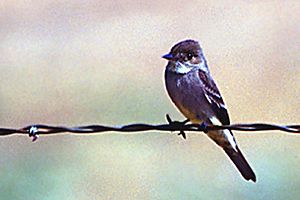Greater pewee facts for kids
Quick facts for kids Greater pewee |
|
|---|---|
 |
|
| Conservation status | |
| Scientific classification | |
| Genus: |
Contopus
|
| Species: |
pertinax
|
 |
|
The greater pewee (Contopus pertinax) is a fascinating bird. It belongs to a group called passerines, which are often called "perching birds." This bird is also part of the tyrant flycatcher family. You can find the greater pewee living further north than many other bird species found in Mexico. This bird used to be known as Coues' flycatcher.
Contents
What Does It Look Like?
The greater pewee is a bit bigger than another bird called the olive-sided flycatcher. It is the largest Contopus flycatcher that breeds in the United States. This bird has a dull gray-brown color all over its body. Some greater pewees might have a light buff (yellowish-tan) color on their chest.
You might notice they have faint wingbars on their wings. They also have a very clear crest of feathers on their head. A great way to tell them apart from olive-sided flycatchers is their bright orange lower beak. This is especially helpful in eastern Arizona and west-central New Mexico. Greater pewees are about 8 inches (20.3 cm) long. Their wings can spread out to about 13 inches (33 cm). They weigh around 1 ounce (28 g), which is about the same as a slice of bread!
How Do They Behave?
Greater pewees love to hang out high up in trees. From their tall perches, they look for insects to eat. They are very good at catching insects in the air. This is called "sallying" or "hawking." They fly out quickly to grab an insect and then return to their perch.
These birds are very protective of their nesting areas. They will bravely attack bigger birds like hawks and jays. They even chase away squirrels if they get too close to their nests! Their main food is insects. But in cooler months, they might also eat some berries.
Their song is quite special and easy to remember. It sounds like a whistled five-syllable tune: deelip deeree! ah. Many people say it sounds like "jose maria." The "deelip" part is often repeated several times before the rest of the song. They also make "pip" calls, similar to the olive-sided flycatcher.
Where Do They Live?
The greater pewee likes to live in mountain pine forests. They often choose areas where there are oak trees growing below the pines. You can also find them in mountain forests with deciduous trees, which are trees that lose their leaves. They especially like Arizona sycamore trees. They also live in mixed forests that have both oak and pine trees.
These birds are easier to find in places that are higher up. In Arizona and New Mexico, they are usually found at elevations over 6,500 feet. They are not very common in western Texas.
Where Can You Find Them?
You can find the greater pewee all year long in central and southern Mexico. Their home range stretches south through Costa Rica and Nicaragua. They breed, meaning they raise their young, from central Mexico north into southeast and central Arizona and southwest New Mexico. It's rare to see them in southern California, southern Nevada, or western Texas.
Reproduction and Nesting
The female greater pewee is in charge of building the nest. She usually builds it high up in a horizontal fork of a conifer tree, like a pine or fir. The nest is built very compactly and is held in place with cobwebs. It is made from grass and weeds. The female often decorates the outside of the nest with lichen, which helps it blend in with the tree. The inside of the nest is usually lined with soft, fine grasses.
The female lays three or four eggs. The eggs are a creamy white color. They have a few brown and olive marks, sometimes in a ring around the wider end of the egg. Each egg is about 0.8 inches (21 mm) long.
See also
 In Spanish: Pibí tengofrío para niños
In Spanish: Pibí tengofrío para niños


